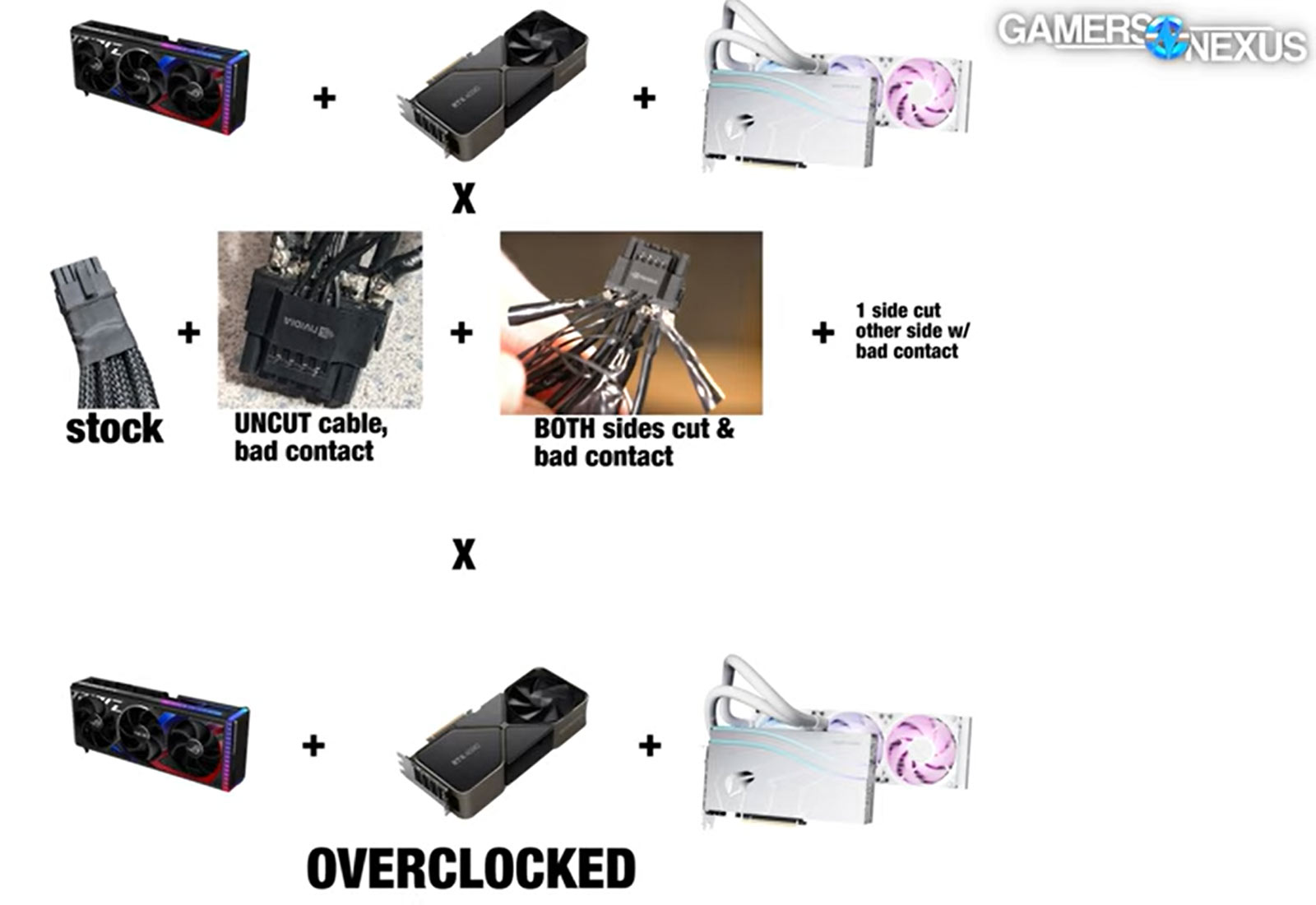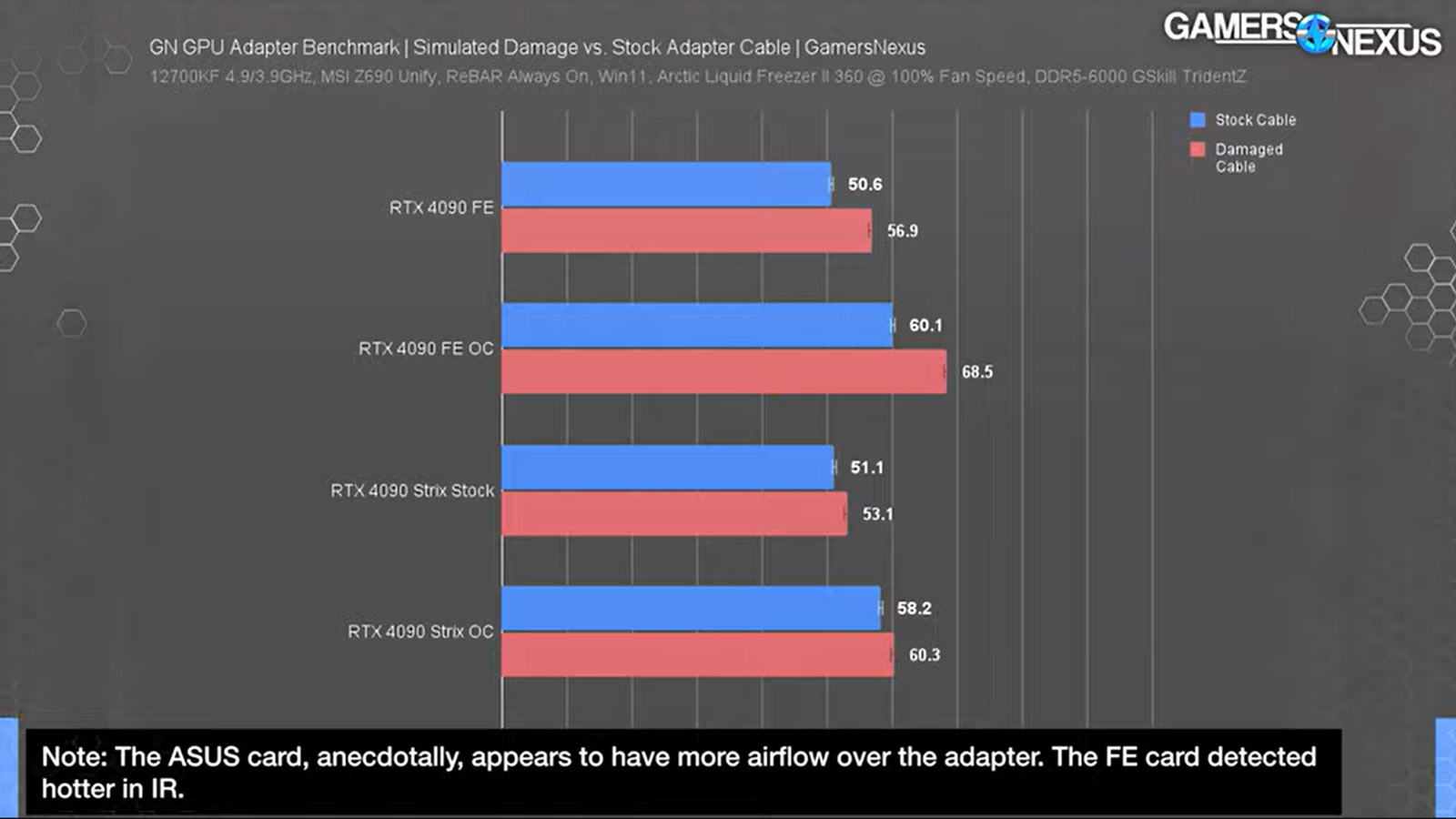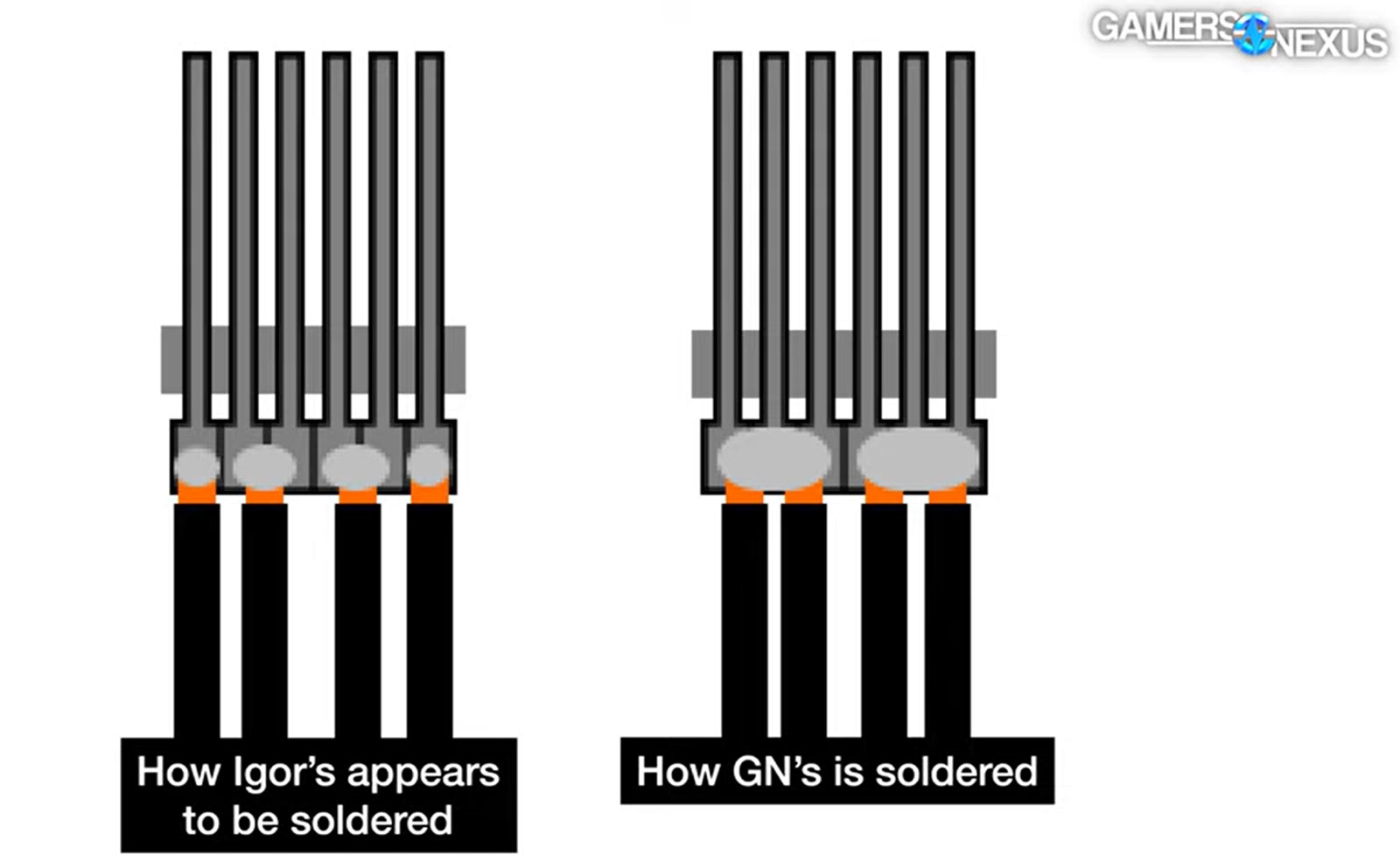RTX 4090 16-Pin Cable Surveys Indicate Some Use 'Under Spec' Wiring
The Nvidia GeForce RTX 4090 power cable melting issue continues to confound. As more information is dug up and presented, the picture isn’t always becoming clearer. The RTX 4090 may be one of the best graphics cards, but it's in a difficult spot right now in terms of supply, pricing, and whether or not the adapters are 'safe' for long-term use. We'll need Nvidia to publish an official statement about the observed issues, as there appear to be so many variables that even the biggest tech sites and video channels haven't been able to come to any helpful conclusions.
For example, on Saturday we reported on Igor’s Labs’ findings with regard to the underlying factors causing the 16-pin power connector melting issues. Igor found that one of his cables was constructed in such a way that important connectors could 'easily' fail, and he suggested cable makers crimp rather than solder the connector joints.
Igor’s reasoning was basically that soldering is less than ideal for any connector that may be subject to pressure, stress, or strain. Solder joints created without due care can be brittle, feature air bubbles, or introduce corrosive compounds to the wiring. Instead, manufacturers should use inherently flexible wiring plus crimped joins, which are said to be more amenable to flexing. However, Igor’s destructive testing of his cable didn’t produce the socket melting issue.
Then on Sunday, Steve Burke of Gamers Nexus (GN) published a video on this same topic. GN sought to do more extensive testing and tried very hard to replicate the melting socket using a selection of five cables from various sources, three powerful RTX 4090 graphics cards, and running for multiple hours at stock and overclocked (>600W) settings. GN even invested in new thermal imaging equipment to get to the bottom of this problem. Armed with a quintet of cables, a trio of GPUs, and thermal cameras and probes, the testing began.
In the course of its investigations, GN peeled back the adhesive strain-relief tape and exposed the area of the metal cabling / connectors inside the GPU power plugs. It did so carefully, “without damaging them.” Burke recalled that Igor’s investigations revealed the power and ground lines used 150V cabling, however, with all five adapters that GN had, they found all used component cables labeled as rated for 300V (14AWG, 105C).
Partners that GN spoke to indicated that the 300V cabling was on spec, which means Igor’s cable must have been under-spec. The specification requires 300V 14AWG for power delivery, though the four 'sensing wires' can use a lower gauge. There were other differences, for example where Igor said that removing the sleeve could cause underlying thin plate metal to “tear immediately,” no such problems were observed at GN. For some other important differences in Igor’s and GN’s cables, check the diagram below.
With the more substantial solder points, more evenly distributed power delivery, and 300V rated wires (they are labeled), GN was unable to reproduce any overheating issues, even though they tried various 'worst-case' connector destruction methods. Below you can see a chart showing that even the worst damage could only muster an 8C temperature increase around the connector area, and that was with up to eight hours of continuous stress testing.


In summary, even though it ran some of the highest power overclocked settings with quite severely damaged cables, GN didn’t experience any failures. There were no melting cables or sockets, no smoke, and no fire. Note that Igor’s testing didn’t show any melting either; he just theorized about how it might have happened. That's the problem with theorycrafting, GN notes in its video.
Surveys: 150V Wires Not so Common
With the revelations about differently soldered cables with different component wire (150 or 300V), both GN and Hardware Luxxe have reached out to readers on Twitter to gauge the mix of cables that have been shipped. According to GN, from 130 responses, just seven received adaptors using 150V rates cables — that's just 5.4% of all adapters surveyed so far. It appears most of these users purchased Zotac branded graphics cards.
The Hardware Luxx results were quite a bit worse on the whole. 79% of respondents received 16-pin adapters with 300V wiring. Note however that the 12VHPWR adapter thread currently only has 29 responses to the survey so far. Still, it's interesting that the percentage of 16AWG adapters on the surface appears to be much higher in Germany than in the U.S. based on site demographics.
Don't panic if you have an adapter with AWG16 150V wires. So far, we know of no correlation between the wire gauge and the incidence of connector melting. Still, given there are at least 15 'documented' cases of melted adapters at present, anyone with an RTX 4090 should exercise caution until Nvidia and its partners release an official statement as to what's going on. We suggest periodic checks to see if your adapter is getting particularly hot... or alternatively, just don't use an adapter (or the card) for the time being.
Tom’s Hardware’s Five Cables
We have tested five different RTX 4090 cards — one of which, the Asus RTX 4090 ROG Strix is now with our CPU reviewer, so we didn't check its adapter cable. All have come with what appears to be an identical adapter design, and pulling back the tape to check things out, they're all using 300V 14AWG wires.
These are likely from the same supplier as the samples Gamers Nexus checked, but we haven't gone any further with our dissection as we want to keep using the adapters and cards. The RTX 4090 cards we used for these adapters are the Nvidia RTX 4090 Founders Edition, MSI RTX 4090 Suprim Liquid X, Gigabyte RTX 4090 Gaming OC, and Colorful RTX 4090 Vulcan OC.
Get Tom's Hardware's best news and in-depth reviews, straight to your inbox.

Mark Tyson is a news editor at Tom's Hardware. He enjoys covering the full breadth of PC tech; from business and semiconductor design to products approaching the edge of reason.
-
mfellows If the adapter ideally uses 14g, should we be worried about CableMod using 16g for their direct to PSU 12vhpwr cables?Reply -
-Fran- As I said in the Discord, someone (company or individual) really screwed nVidia with this one.Reply
Regards. -
TechieTwo From a technical standpoint a 16 AWG stranded wire of one foot can easily and safely carry 18 amps continuously, i.e. 216 watts per wire @ 12v. Four 16 AWG power supply wires thus can safely supply 864 watts - far beyond the power consumption of the RTX 4090. Thus the 16 AWG wire should not be an issue in overheating. Poor / high resistant connection of terminals to the wires or terminal-to-terminal contact however can cause overheating issues.Reply -
logainofhades Yea this stuff is melting due to poor connections. A broken wire, as long as said wire isn't close enough to arc, it also will not cause a melting of the plug. I believe jay proved that one, when he clipped the wires, and nothing melted. A broken solder joint, though, is most likely going to arc and melt the connector.Reply -
Kamen Rider Blade I thought nVIDIA was sole sourcing the Adapters for QC reasons.Reply
Why is there so much manufacturing variance in the parts including some 150V & 300V cables?
Astron being shoddy / shaddy again? -
DavidLejdar ReplyTechieTwo said:From a technical standpoint a 16 AWG stranded wire of one foot can easily and safely carry 18 amps continuously, i.e. 216 watts per wire @ 12v. Four 16 AWG power supply wires thus can safely supply 864 watts - far beyond the power consumption of the RTX 4090. Thus the 16 AWG wire should not be an issue in overheating. Poor / high resistant connection of terminals to the wires or terminal-to-terminal contact however can cause overheating issues.
So technically, could a 300(+75) Watt GPU be easily supplied via a 6-pin connector? -
PlaneInTheSky $1600 GPU with cables that can catch fire.Reply
The future is here ladies and gentlemen. -
Amdlova When a power supply dies I cut the cables to use in other projects and the reality same model has bad cables, chineses manufactures tend to make the profit way and fake the products. Need to measure the wire instead of the printing. I see a lot of aluminum cables or something like a fake cooper.Reply


